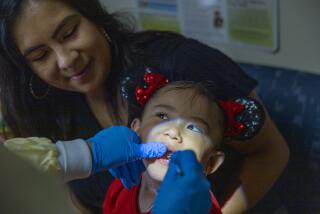As fillings come out, titanium implants go in
Westwood resident Lynn Parana can’t remember what she ate that caused her back molar to crack. But the toothache was severe enough that she called her dentist.
Breaking the news that Parana would need more than a crown, he sent her to a periodontist who determined that the tooth, which had a filling in it, had a crack so deep that a root canal would fail. “Here I was afraid of having a root canal,” said Parana, “then I realized that would have been the good news.”
The periodontist recommended that she have the tooth extracted.
“I was shocked to be in this position,” said Parana, who is healthy, prides herself on her oral hygiene and has never had a root canal or gum disease. “I didn’t think people like me lost their teeth. The news makes you feel like Ma Kettle in a hurry.”
The post-extraction options weren’t appealing. She could choose not to replace the tooth, but the other teeth would shift and she’d probably lose the molar above the missing one. She could get a partial bridge, but with only one tooth to act as an anchor, the bridge would be unstable. A dental implant was her third option.
Though the idea of having someone drill a screw into her jawbone gave Parana considerable pause, she decided it was by far the best option.
“An implant sounded painful, but I certainly did not want to go around with a missing tooth,” said Parana, a transaction coordinator for Coldwell Banker in Beverly Hills. “I’ve always heard that when you start losing teeth, other health problems follow. It’s a downhill slide.”
And with that decision, Parana joined the wave of baby boomers getting implants.
Because of the large fillings that characterized dentistry years ago, 40- to 60-year-olds comprise the fastest-growing group of patients seeking the dental procedure, said Kevin O’Grady, former president of the American Academy of Implant Dentistry. Teeth with large fillings are especially likely to crack with age, and if they crack far enough below the gum line, even a root canal can’t save them.
Implants are titanium screws that surgeons insert deeply into the jawbone. After the bone and implant fuse, surgeons attach a post to the screw and to that they attach a crown. A procedure first developed in the 1950s, dental implants didn’t enter the mainstream until the 1980s.
“Toward the end of the 1980s, the procedure went from being a last-ditch effort, to the best treatment for most missing teeth,” said O’Grady.
Today, according to the American Academy of Implant Dentistry in Chicago, around 70 million to 80 million people in this country have a missing tooth they’ve never replaced. An additional 15 million have a bridge replacing a missing tooth or teeth. Approximately 3 million have implants, and that group is growing at a rate of around 500,000 a year.
Part of that growth is due to better success rates. Internationally, the success rate of implants in the lower jaw is 95% and for the upper jaw it’s 90%, said Parana’s dentist, Robert B. Gerber at Cedars-Sinai Medical Center. Twenty-five years ago, the overall success rate was 20% to 30%.
Placing an implant in the upper jaw is more complex because sinus cavities are close by, and the bone is thinner, said Michael Borenstein, a Beverly Hills oral surgeon and an associate clinical professor at Los Angeles County-USC Medical Center, who performed Parana’s implant surgery.
These patients often require a bone graft before the surgeon can place an implant. Doctors get bone from either the patient or a bone bank, or they use synthetic bone.
People who smoke or drink heavily are not good candidates because such habits interfere with healing. Similarly, people who have uncontrolled diabetes or active gum disease need to have their diseases in check before having an implant.
But most people are candidates. Age is no barrier so long as a patient is in good health, O’Grady says.
“Barring any systemic disease, patients can expect implants to last the rest of their lives,” he says. “Certainly, 20 to 25 years is not unrealistic.”
Besides a deep fracture, other reasons for missing teeth include severe decay, gum disease, or congenitally missing teeth.
Some children are born without one or several permanent teeth in their head. When the corresponding baby tooth falls out, the child has no permanent replacement tooth. These children are usually good implant candidates, but not until they have finished growing. For girls that’s around age 17 or 18, for boys a bit later.
Despite all they offer, dental implants have their downside: time and money. For Parana, a full year passed between the day she broke her tooth and the day the new crown was in place. She spent the first month collecting opinions. The second month she had the tooth extracted. After that, she waited several months, as implant surgeons recommend, for the site to heal.
Finally, in February 2005, Borenstein placed her implant. He wanted the area to heal for another three to six months before adding the pressure of a crown. Four months later, Gerber fitted Parana for a crown, which took a few weeks to mold, make and place.
If a patient needs a bone or gum graft, the process can take even longer. The whole procedure costs around $5,000, she said. Her dental insurance paid only $975, for the consultation and the extraction, which is more than most plans cover.
Paying was the most painful part. The procedure itself, she said, was practically painless. Borenstein used only a local anesthetic. Parana remembers he only drilled a few times for four to five seconds. She didn’t even need painkillers afterward.
During both healing phases, she ate soft foods at first, tried to chew on the other side of her mouth, and avoided foods such as chips or popcorn that could traumatize the gum tissue. She saw Borenstein monthly, so he could monitor her healing.
Now the new tooth blends in with her other teeth, and looks just like the one it replaced, minus the filling.
“I imagined the worst at every turn. But the whole experience, though lengthy, was painless and worth it,” she said. “Still, I hope I never have to do this again.”
*
(BEGIN TEXT OF INFOBOX)
A guide to coverage, surgeons
Paying for an implant
Although dental experts and insurance companies agree that dental implants are better than bridges for replacing missing teeth, most dental plans cover bridges but not implants.
In Southern California, implants cost around $5,000. About half the fee covers the surgery, and the other half the restorative crown. In other parts of the country, costs are lower.
“There’s no logic,” says Kevin O’Grady, former president of the American Academy of Implant Dentistry. “Insurance companies will pay for a three-part bridge to replace a tooth, which is almost as expensive. But not for an implant, which will last longer, not harm adjacent teeth and be cheaper in the long run.”
But don’t place all the blame on the insurance companies. “We recognize that implants are the best way to replace missing teeth, and we’re willing to cover it,” says Jeff Album, spokesman for Delta Dental of California. “The problem is employers don’t want to pay the extra to add the coverage to their plan.”
With the cost of medical benefits rising rapidly, Album says, most employers are reluctant to add new coverage. Keeping the status quo is expensive enough. Even now, much of the U.S. population does not have dental insurance, and many employers do not offer dental benefits at all. So dental implants require a hefty out-of-pocket expense.
“Yes, it’s expensive,” says Robert B. Gerber, a Los Angeles dentist, “and it’s unfortunate more dental plans don’t cover it. Then again, I see a lot of patients who could benefit from an implant buying plasma televisions.”
Finding an implant surgeon
When choosing an implant surgeon, do your homework.
All dentists are licensed to place implants, but that doesn’t mean they can or should, O’Grady says.
Patients often start with their general dentists, who then refer them to an implant surgeon. This team approach often works quite well. However, if your dentist says he or she can do the procedure for you, ask about training, how many implants he or she has placed, the success rate -- and then get a second opinion.
You can also check on the American Academy of Implant Dentistry website (www.aaid-implant.cnchost.com) to see if the practitioner has passed the peer-reviewed screening to be a member. Members include dentists, periodontists and oral surgeons; however, some well-qualified implant specialists are not members.
More to Read
Sign up for Essential California
The most important California stories and recommendations in your inbox every morning.
You may occasionally receive promotional content from the Los Angeles Times.










